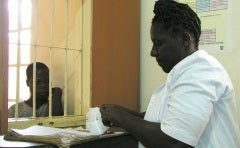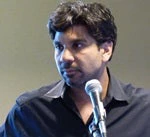 Patricio Marquez’s post correctly identifies lack of access to quality medicines as one of the constraints to poor people’s health in Africa. But the solutions he recommends—more public money for “essential drugs benefits”, building resilient institutions, and providing physicians with better scientific information and guidelines about drug prescriptions—are unlikely by themselves to improve poor people’s health outcomes.
Patricio Marquez’s post correctly identifies lack of access to quality medicines as one of the constraints to poor people’s health in Africa. But the solutions he recommends—more public money for “essential drugs benefits”, building resilient institutions, and providing physicians with better scientific information and guidelines about drug prescriptions—are unlikely by themselves to improve poor people’s health outcomes.
More public money. Patricio notes that out-of-pocket expenditures are about 40 percent of total health expenditures and most of this is spent on outpatient drugs. He assumes the reason is that countries have not adopted a program of essential drugs benefits, and the reason for the latter is lack of public resources. But consider the following facts.
- Money that is currently spent on drugs and other materials “leaks” before it gets to the ultimate beneficiary—sometimes at alarming rates. In Chad, the leakage rate is 99 percent.
- Health workers in public primary clinics in Senegal and Tanzania are absent 20 and 21 percent of the time, respectively. When present, they spend a total of 39 and 29 minutes a day counseling patients.
- In most countries, when doctors do treat patients in public clinics, low competence and low effort seriously impede the provision of correct diagnoses and treatment.
These facts suggest that there are serious problems with the way public money is currently being spent. And the reasons have to do with incentives. Drugs are worth a lot in the open market, and they are easy to steal—which is why poor people don’t get them for free. Likewise, doctors are paid regardless of whether they show up for work. And when they are at work, they give low quality service that encourages patients to go to their private clinics, where they are charged. Furthermore, in Indonesia, India and Tanzania, there is no correlation between measures of structural quality (like the availability of medicines) and the quality of medical advice.
In such a setting, how would allocating more public money for drugs improve poor people’s access to quality health care?
Building resilient institutions. Acknowledging that there are “institutional weaknesses in the health system”, Patricio suggests building “resilient institutions and systems to facilitate access to and promote the rational use of medicines.” Some of the proposals do not address the fundamental problem of incentives to deliver quality services to the poor. For instance, he cites the use of a scratch-off labeling system in Nigeria that reduces the flow of counterfeit drugs. That’s fine, but how will this reduce the leakage rate? Or absenteeism among doctors? Likewise, giving physicians more knowledge and adopting clinical guidelines may improve the quality of care, since they don’t seem to be using the knowledge they already have.
He mentions a pilot project in Zambia where district-level planners manage orders and deliver drugs more efficiently. But this suggests the problem was lack of planning, rather than one of incentives. When the pilot is scaled up, what incentives will the district-level planners have to deliver drugs efficiently? And why would we favor such a system to logistics run by private sector pharmacies (Coca-Cola appears in every village in Africa with no problems) combined with direct fiscal subsidies to households for particular drugs?
Patricio’s example of using Coca-Cola’s distribution system to deliver anti-AIDS drugs in Tanzania begins to get to the heart of the matter. The reason Coca-Cola has such an efficient supply chain is that customers pay for their drinks, so the “providers” have an incentive to deliver. Most drugs too are private goods (in that the only beneficiary is the patient) but, in our effort to make sure poor people get access to them, we provide them for free—to everybody. This creates a huge “rent”—the difference between the value of the drug and its market price—that is then captured by the non-poor—including the people who steal the drugs from the clinic and the doctors who are absent. As a result, the poor—the very people the policy was intended to benefit—lose out.
The solution therefore is not to pour more money into a leaking bucket—or provide absentee doctors with better information—but to empower poor people with the ability to hold health workers and drug providers accountable. One way would be to charge market prices for drugs*, but give poor people (and only poor people) vouchers or additional cash to buy the drugs. And why not do the same for clinical services? The details will depend on country circumstances, and such schemes will face political resistance from those whose accountability is increased, but the simple principle of “money following the patient” (rather than the doctor or drug provider) could go a long way to improving poor people’s access to drugs.
* In 1982, two researchers in the Dominican Republic noticed something funny going on in the country’s primary health care centers1. Not only was the number of daily consultations very low (14), so that doctors spent 56 minutes per day seeing patients, but the utilization of the clinic was erratic, with 20 consultations some weeks and 140 in others. The reason?
“According to the attending physician, when people knew the monthly supply of medicines had arrived, they hastened to the clinic, not in search of diagnosis but to request free medicines. In conversations with villagers we found that it was not infrequent to given chickens the antibiotics received at the clinic.”
The researchers went ahead and bravely introduced a user-cost for medicines after ensuring that particularly poor people were exempt. Subsequently,
- The number of consultations was minimally affected (declines of 5.7%).
- The fluctuations died out and consultations became more even.
___________
1. Ugalde A and N Homedes. Medicines and Rural Health Services: an Experiment in the Dominican Republic. In S. van der Geest and R. Whyte (eds). The Context Of Medicines In Developing Countries: Studies In Pharmaceutical Anthropology. Kluwer Academic Publishers. Pp: 57-79.



Join the Conversation